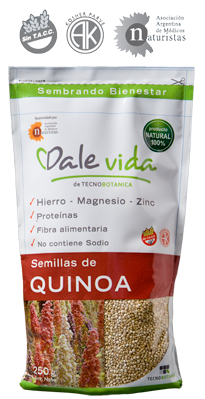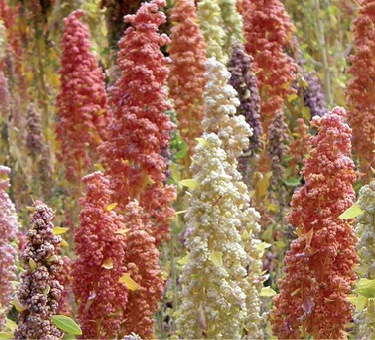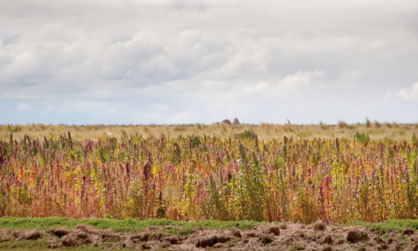Quinoa
 Historical Review
Historical Review
Quinoa is a crop originally from Peru, which is the top producer in the world. It is cultivated in the Andes of Peru, Argentina, Bolivia, Chile, Colombia, Ecuador and the US.
It is considered a sacred seed, it has been grown in the Andes (Bolivia, Peru, Ecuador and Argentina) for 5,000 years. It was called the “mother grain” by the Inca, due to its great nutritional importance. It was considered a gift from the gods which made those peoples one of the most important cultures of ancient times. Like the potato, quinoa was one of the staple foods of the Andean peoples before the Incas and during Incas times. Inca warriors ate some “war balls” made of quinoa and fat to support the long marches and battles.
Since ancient times, quinoa has also been considered a medicinal plant by most of the Andean peoples.
According to the UN, quinoa comes closest to the ideal nutrient and protein balance in human food. It has high-biological proteins and a high content of amino acids that play an important role during the growth stage: muscle development, central nervous system and intellectual capacity.
The average protein level in the grain is 16%, but it can have up to 23%, which is more than double the level in any other cereal.
Quinoa has an exceptional balance of proteins, fat, oil and starch, as well as a high content of amino acids. Among the amino acids are lysine (important for the development of the brain) and argentine and histidine, basic for human development during childhood.
It has 8 essential amino acids, which make it a very complete food, easy to digest. It is rich in methionine and cystine, in minerals, such as iron, calcium and phosphorous and vitamins, whereas it is poor in fats, complementing in this way other grains and/or legumes. It has 4%-9% of fat, half of which has linoleic acid, essential for the human diet. It has also a high level of calcium, phosphorous and iron.
Celiac individuals can consume it because it does not contain gluten.
Quinoa International Launch
“Quinoa can play an important role in eradicating hunger, malnutrition and poverty,” expressed José Graziano da Silva, FAO General Director, at the official launch of the International Year of Quinoa at the United Nations Headquarters.
A future cultivated a thousand years ago
Quinoa properties can not only be found in the grains of its colorful panicles, but also in the knowledge gathered by the Andean peoples that have made it possible to preserve its different varieties, improve its productivity and develop a gastronomic tradition around this grain.
The grain was carefully protected by these peoples and today is an invaluable legacy for humanity due to its unique characteristics. Quinoa is the only vegetable that has all the essential amino acids, oligoelements and vitamins for life, apart from not having gluten.
It can grow in the most adverse weather conditions, supporting temperatures from -8°C to 38°C. It can be cultivated at the sea level up to 4,000 meters height and resist droughts and poor soils.
FROM STAPLE FOOD TO GOURMET KITCHEN
Like the potato, quinoa was one of the main foods of the Andean peoples before the Incas. Traditionally, quinoa grains are roasted and then ground into to flour, with which different types of breads are baked.
They can also be cooked, added to soups, used as cereal, made into pasta and even fermented to get beer or chicha, the traditional drink of the Andes. When cooked, it takes on a nut-like flavor.
Today quinoa also plays a key role in gourmet kitchens, but its uses have also been extended to the pharmaceutical and industrial areas.
FROM AMERICA TO THE WORLD
Almost all the current quinoa production is carried out by small farmers and associations.
Quinoa can be found natively in all countries of the Andean region, from Colombia to the north of Argentina and the south of Chile. The main producing countries are Bolivia, Peru and the US. Cultivation of quinoa has transcended continental boundaries: it is being cultivated in France, England, Sweden, Denmark, Holland and Italy. In the US, it is grown in Colorado and Nevada, and in Canada, in the fields of Ontario. It has shown high yields in Kenya, and the crop can be successfully developed in the Himalayas and the plains of northern India as well.
A CONTRIBUTION TO GLOBAL FOOD SECURITY
Faced with the challenge of increasing production of quality food to feed the world’s population in the context of climate change, quinoa offers an alternative for those countries suffering from food insecurity.
Therefore, the United Nations General Assembly has declared 2013 as the “International Year of Quinoa”, in recognition of ancestral practices of the Andean peoples, who have managed to preserve quinoa in its natural state as food for present and future generations, through ancestral practices of living in harmony with nature.
The Food and Agriculture Organization (FAO) of the United Nations, and specifically its Regional Office for Latin America and the Caribbean, will serve as the Secretariat of the International Year of Quinoa, assisting the International Committee to coordinate the celebrations. Bolivia has the presidency of the Committee, while Ecuador, Peru and Chile share the vice presidency, with the rapporteurships in the hands of Argentina and France.


